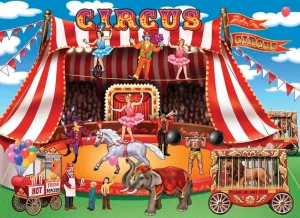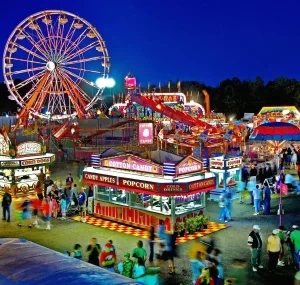Circus and Carnival: A circus is an entertainment event that involves jugglers and acrobats as well as stuntmen, clowns, and other professional performers. They travel around the country to increase their popularity. The circuses often use trained animals and enticing objects to attract audiences. The circus usually takes place in a circular tent or outdoor ring.
Carnivals are festivals that pay homage to a religious, cultural or historical figure. The carnival includes a variety of rides and stalls selling toys, candy, and other trinkets as well as shows. The carnival can be a huge outdoor space where people are able to walk and choose the entertainment they want.
Definition of Circus

A circus is an entertainment form combining spectacular performances, skilled tricks, and thrilling displays. A traveling troupe of performers often demonstrates their talents, such as acrobatics and aerial acts; juggling; animal training, or clowning may also be performed by these traveling troupes. A circus ring consists of an oval or circular arena with seating available to audiences and is known for captivating audiences with daring stunts and captivating storytelling techniques. SF
Definition of Carnival

Carnival is an annual festival and celebration featuring vibrant public gatherings with colorful and extravagant public festivities, usually preceding Lent. Carnival typically lasts several days and features street performances, parties, parades, and other forms of festivities that include street performances by street performers; parties; parades; elaborate floats as well as street performances and parties in many countries and regions around the world. Carnival celebrates people coming together, reveling in creativity while reveling in joy before Lent begins when soul searching and abstinence become part of daily life again.
Origins and History
A. Circus
The circus can be traced back to ancient civilizations such as Egypt, Greece, and Rome; ancient Egyptians and Greeks featured acrobats and jugglers while Romans included gladiatorial races and chariot racing as part of their performances.
Influence of Equestrian and Acrobatic Shows:
- Beginning during the Middle Ages, European countries enjoyed hosting equestrian and jousting competitions that featured knightly competitions and skilled horsemanship demonstrations. Chinese, Indian, and Arabian cultures all included some form of acrobatic performances as part of their cultures.
- Philip Astley, an Englishman in the late 18th Century, was one of the pioneers of what we now refer to as the modern circus. Combining equestrian performances, acrobatics, and other acts within a circular arena created By 1768 the first permanent circus had been established in London; from there its influence spread throughout Europe before finally reaching America where it flourished over time.
B. Carnival
Carnival can trace its roots back to ancient pagan celebrations and Roman Saturnalia. These festivals commemorated the transition from winter to spring with feasting, revelry, and breaking social norms.
Medieval Processions and Fairs:
- Carnivals were an annual rite in medieval Europe that marked the end of winter and pre-Lenten celebrations, while towns and villages organized fairs and processions, where people enjoyed street performances, dancing, feasting, masks, and costumes to hide identities while having fun!
- The transition from medieval carnival to modern carnival. The Middle Ages saw Christianity influence carnival traditions, particularly during Shrovetide (or Carnival season) before Lent began. Masquerade balls and elaborate floats became organized features of festivities; different countries developed their own carnival traditions such as Rio de Janeiro’s and Venice’s.
- Both circus and carnival have long histories, with the former stemming from ancient performances and equestrian displays, while later deriving from ancient pagan celebrations and medieval festivals.
Concept and Structure
A. Circus
A circus provides live entertainment through performances. Acts are choreographed to show off performers’ talents and abilities, delighting their audiences while entertaining at the same time.
Circus performances often showcase trained animals and aerial acts. Acts featuring elephants, lions, and tigers performing stunts and tricks is common at circuses; high-wire acts, trapeze shows, and contortionists also remain popular forms of acrobatic entertainment. Finally, aerial acts feature performers suspended on apparatuses displaying beautiful displays of grace and strength that leave audiences speechless.
B. Carnival
- Carnival is an annual festival celebrated throughout many parts of the world that invites both participants and observers to take part. It creates an enjoyable environment in which individuals can partake in various activities while having a good time.
- Carnivals provide participants with entertainment through games, rides, and attractions such as inflatable slides and rides. Participants have an opportunity to win prizes while having fun.
- Parades are an integral component of carnival. They typically feature elaborately decorated floats and performers dressed in costumes, along with music and dance. Street performances such as stilt walkers or masquerade bands often add an exciting atmosphere.
- Circuses are known for live performances featuring trained circus animals, acrobatics, and their iconic tent and ring. Carnival on the other hand aims to provide an engaging interactive experience through various attractions, games, and rides as well as parades and street performances. Both forms of entertainment offer something different; their main goals and structures differ significantly.
Entertainment Offerings
A. Circus
Animal Displays and Acts Animals in Shows: Circuses often include animal displays to add entertainment for audiences. Under the supervision of qualified trainers, horses, and elephants often perform intricate tricks or stunts that wow audiences.
Trapeze and Aerial Acts: Circus performances showcasing aerial acts are the highlight of an evening at any circus. Aerial silks, hoops, and trapezes are used by performers to demonstrate strength, agility, and daring. Flips, spins and graceful movements above the circus ring often accompany these spectacular aerial performances.
Circus performances frequently showcase comedic acts like juggling, clowning, and other comedic performances that amaze their audiences with dexterity, coordination, and skill. Clowns provide comic relief by performing tricks, jokes, and skits with humorous results; other comedic acts include mime artists and contortionists as well as eccentric characters that add another level of fun and laughter.
B. Carnival
- Carnivals are well known for providing thrill-packed experiences. Roller coasters, Ferris wheels, spinning rides, and other attractions provide thrills and excitement to visitors seeking thrills and excitement.
- Carnivals feature various booths offering skill-based challenges and games, offering participants an opportunity to test their luck while competing in friendly and winning prizes. Common activities at carnivals include shooting darts at targets or knocking objects down with darts; shooting darts is also popular as is playing accuracy games such as dart shooting. Carnival participants can compete friendly for prizes while enjoying themselves!
- Carnival celebrations often feature street performers, street dancers, and live music. Dancers, musicians, and DJs create an energetic environment while street performers such as acrobats, magicians or living statues, and fire breathers can mesmerize an audience with their talent and interaction with its members.
- Carnival and circus both provide diverse forms of entertainment options, from animal acts and aerial acts to comedic performances like juggling or clowning, while carnivals provide thrilling rides, games booths, street entertainment as well as live music and dance performances. Each type of entertainment offers something special and engaging for every interest and preference.
Atmosphere and Experience
A. Circus
Audience Intimacy and Focus: Circus provides an intimate setting where audiences are right alongside performers. A tent or venue of the circus creates an enclosed environment to strengthen connections between performers and spectators – creating an unforgettable experience of amazement and amazement for both sides of the viewing experience. This intimate environment fosters a greater sense of immersion and amazement from spectators as well as performers alike.
Circuses are famed for their thrilling acts, spectacular displays, and daring feats that mesmerize audiences and captivate them with stunning stunts and suspenseful stunts. Circus performers create moments of suspense that leave audiences breathless; music and lighting add drama and increase overall excitement and wonderment in an audience experience.
Interaction Between Performers and Audience: Some circus acts involve engaging the audience to gain participation or reactions from them, with clowns creating moments of entertainment or laughter among spectators. This interactive element enhances the overall experience while creating a bond between performers and audience members.
B. Carnivals
- Carnivals are known for creating an energetic and festive environment. Streets and venues become vibrant with people, music, colorful decorations, laughter, and celebratory spirit – an atmosphere filled with celebration and energy!
- Carnival goers enjoy a mix of excitement and enjoyment. All ages can participate in its attractions, games, and rides; participants can choose their level of participation. Carnival provides an enjoyable and relaxing experience whether riding rollercoasters, playing games, or simply strolling through to take in the sights and sounds.
- Carnival provides an opportunity for community involvement and social engagement, bringing people together to share experiences and celebrate together. Families, friends, and communities come together each year at carnival time to come to celebrate together while sharing memories and enjoying all that comes with it!
- Circuses are known for creating an intimate environment, suspenseful performances, and interactive audiences; carnivals offer more vibrant environments with opportunities for thrill-seeking enjoyment as well as socialization opportunities. Both environments provide distinct experiences that add to the overall enjoyment.
Cultural Significance and Context
A. Circus
History and Popular Culture: Circus plays an essential part in entertainment history and popular culture, providing entertainment and respite from everyday routines while offering stunning performances that bring communities together.
Symbolism: Circuses have long been associated with magic, wonder, and dreams. It offers ordinary people the chance to become extraordinary performers through extraordinary talent transformation – an atmosphere that has inspired artists, writers, and filmmakers alike.
Influence on performing arts and circus traditions worldwide: Circus has had an immense effect on performing arts worldwide, contributing significantly to many traditions associated with it. Acrobatics and aerial acts from circus shows and performances have even found their way into theater, dance, and film performances! Additionally, performances that combine elements of traditional circus art with innovative approaches have also taken inspiration from this form of entertainment.
B. Carnival
- Carnival festivities take place around the world and are deeply rooted in local customs and traditions, along with historical events that took place. Carnival represents local culture through folklore, music, and dance as well as costumes, dances, and other forms of entertainment – examples being Rio de Janeiro Carnival in Brazil; Mardi Gras in New Orleans or Venice Carnivals respectively.
- Carnival symbolizes freedom, joy, and indulgence. People come out of hiding to express themselves freely by dressing up in colorful costumes or participating in festive activities at this festive period; social norms can be challenged while enjoying an atmosphere of freedom and celebration.
- Carnival celebrations have an enormously beneficial effect on local economies, tourism, and identities. Carnival-related industries such as costume design, event planning, and hospitality contribute significantly to these regions by drawing in visitors from far and wide who come out for these unique cultural festivals. Carnival-related industries contribute even further by contributing jobs directly.
- Carnival and circus both possess cultural relevance and significance within their respective domains. Circus stands as a timeless icon for entertainment, popular culture, and dreaminess; having had an incredible effect on performing arts traditions worldwide. Carnival celebrates joy and freedom while also creating local identities, drawing tourists, boosting tourism numbers, and providing economic benefit – leaving lasting imprints all around the globe.
Conclusion
Although both the carnival and the circus offer exciting and unforgettable experiences however, they differ in their history and principal attractions, venues and set-ups. The circus is awe-inspiring with its captivating shows performed by skilled performers while the carnival draws crowds with a variety of games and rides. Both types of entertainment have an important spot in the hearts of our people and embody the essence of joy, excitement and joy. If you’re interested in the thrilling acts of circuses or the fun-filled atmosphere of a carnival there is one thing that’s for certain they both offer an array of enjoyment and excitement for everyone those who go.